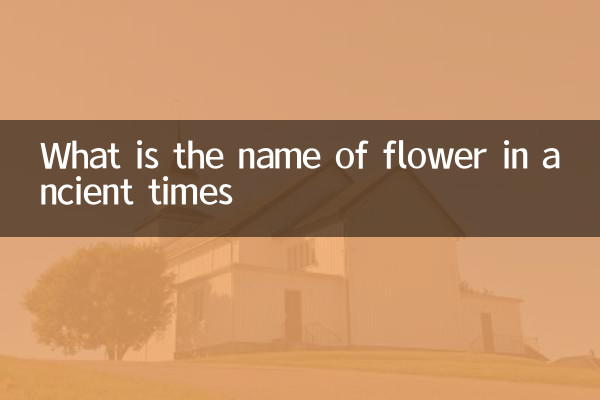What is the name of flower in ancient times
In modern society, we are accustomed to using "flowers" to refer to the beautiful parts of various plants blooming, but in ancient times, people's names of flowers vary according to the differences in times, regions and culture. This article will discuss the ancient name of flowers based on recent hot topics and hot content on the entire network, and display relevant information through structured data.
1. The ancient name for flowers

In ancient documents, there are many names for flowers, including both elegant names and common names. Here are some common ancient flower names and their modern corresponding names:
| Modern flower name | Ancient name | Source |
|---|---|---|
| peony | Wood peony, rich flowers | Compendium of Materia Medica |
| lotus | Fuli, Shuihua | The Book of Songs |
| chrysanthemum | Yannian, Emperor's Flower | "Shennong Bencao Jing" |
| plum bossom | Scented fragrance, jade butterfly | "Fu of Plum Blossoms" |
| Rhododendron | Pomegranate, mountain red | Compendium of Materia Medica |
2. The relationship between recent hot topics and ancient flower names
In the past 10 days, the discussion on traditional culture on the entire network has been very popular, especially ancient clothing, poetry appreciation and other content. Among them, ancient flower names have become the focus of attention of many netizens because of their elegance and meaning. Here are the recent hot topics related to ancient flower names:
| Hot Topics | Related to ancient flower names | Popularity index |
|---|---|---|
| Ancient weddings are on the rise | The cheetah (symbolizes the love between husband and wife) | ★★★★☆ |
| National Fashion Clothing Design | Begonia (commonly used for embroidery patterns) | ★★★☆☆ |
| Poetry Conference Hot | Plum blossoms (often praised by poets) | ★★★★★ |
| Traditional festival rejuvenation | Dogwood (symbol of Double Ninth Festival) | ★★★☆☆ |
3. The cultural significance of ancient flower names
Ancient flower names are not only different names, but also carry rich cultural connotations. For example:
1.peonyIt is called "Fugui Flower", because of its elegance and luxury, it symbolizes prosperity;
2.lotusIt is elegantly called "Fuzi", because it is not stained by the mud, which represents noble character;
3.plum bossomThe other name is "Dianxiang", which reflects its spirit of being proud of the snow and frost, and is often used by literati and poets to describe themselves.
These flower names frequently appear in ancient poetry, paintings, and costumes, and become an important part of Chinese culture.
4. Conclusion
Through the review of ancient flower names, we can not only feel the ancients' delicate observation of nature, but also experience the profound heritage of traditional culture. Among the recent hot topics, the reappearance of ancient flower names also reflects the re-attention and love of modern people for traditional culture. Hopefully this article helps readers better understand these elegant names and the stories behind them.

check the details

check the details